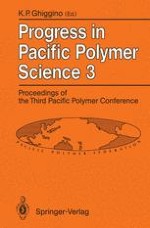1994 | OriginalPaper | Buchkapitel
Spectroscopic Studies of Conducting Polymers on Oxide Catalysts
verfasst von : G. J. Millar, G. F. McCann, G. A. Bowmaker, R. P. Cooney
Erschienen in: Progress in Pacific Polymer Science 3
Verlag: Springer Berlin Heidelberg
Enthalten in: Professional Book Archive
Aktivieren Sie unsere intelligente Suche, um passende Fachinhalte oder Patente zu finden.
Wählen Sie Textabschnitte aus um mit Künstlicher Intelligenz passenden Patente zu finden. powered by
Markieren Sie Textabschnitte, um KI-gestützt weitere passende Inhalte zu finden. powered by
A variety of spectroscopic techniques have been utilised to study the polymerisation of monomers such as acetylene or pyrrole within zeolite channels. The nature of the cations located in the zeolite framework was demonstrated to be a significant factor in the design of a successful catalyst. In particular cesium ions enhanced the degree of acetylene polymerisation relative to the situation with sodium, and copper ions were active for the polymerisation of pyrrole. Other factors such as the presence of Lewis acid sites and the coverage of adsorption sites by acetylene were also determined to be important in the mechanism for acetylene polymerisation. Resonance Raman studies indicated that polypyrrole formed within a zeolite channel was partially charged i.e. in the conducting state. Furthermore, this charge was associated with quinoid structures in the polymer chains. X-ray photoelectron spectroscopy (XPS) and photoacoustic infrared spectroscopy (PAIRS) data also provided evidence for the presence of a charged polymer segment. UV/VIS analysis allowed a detailed band description of the conducting polymer to be assimilated, and the level of doping to be estimated. ESR investigations further demonstrated formation of polaron charge carriers at the expense of Cu2+.
